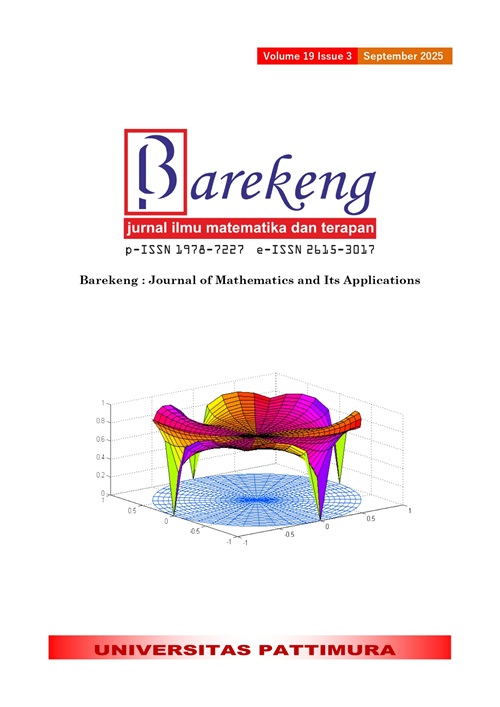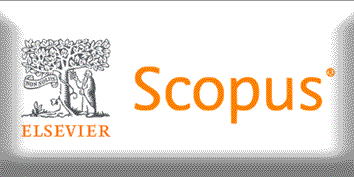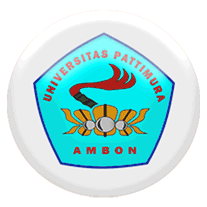ANALYSIS OF EARTHQUAKE SEISMICITY IN MALUKU PROVINCE AND ITS SURROUNDING AREAS USING THE MAXIMUM LIKELIHOOD ESTIMATION METHOD
Abstract
Tectonic earthquakes are natural disasters that occur abruptly over a relatively short period, resulting from the movement of tectonic plates. The Maluku region is classified as prone to seismic activity due to its geographical location at the confluence of three tectonic plates: the Eurasian, Pacific, and Indo-Australian. This study aims to analyze the seismic activity of earthquakes in the Maluku region and its surrounding areas. The methodology employed is based on Descriptive Statistics and Maximum Likelihood Estimation. The data set was obtained from the International Seismological Centre (ISC) and comprises earthquakes occurring in the Maluku region and surrounding areas between 1970-2023. The earthquakes were selected based on the criteria of magnitude > 3.8 Mw and depth < 60 km. The research was facilitated by using various software applications, including Microsoft Excel, SPSS, Matlab, GMT, and Z-map. Descriptive statistics were employed to analyze the hypocenter and epicenter of the earthquake distribution. In contrast, the maximum likelihood method was employed to ascertain the seismicity value and earthquake return period. The findings indicate that the earthquake distribution is relatively dense, except in certain regions within the sea area. The results of the seismicity analysis demonstrate that Sub-region I exhibits the highest level of seismic activity. At the same time, the shortest return period is observed at a magnitude of 3.0 Mw, specifically within Sub-region I.
Downloads
References
P. A. Kabana, R. Kurniawan, R. E. Caraka, B. Pardamean, B. Yuniarto, and Sukim, “BICLUSTERING METHOD TO CAPTURE THE SPATIAL PATTERN AND TO IDENTIFY THE CAUSES OF SOCIAL VULNERABILITY IN INDONESIA : A NEW RECOMMENDATION FOR DISASTER MITIGATION POLICY,” ScienceDirect, pp. 31–37, 2019.doi: https://doi.org/10.1016/j.procs.2019.08.138
H. Z. Abidin, H. Andreas, T. Kato, and T. Ito, “CRUSTAL DEFORMATION STUDIES IN JAVA (INDONESIA) USING GPS,” J. Earthq. Tsunami, vol. 3, no. 2, pp. 77–88, 2009.doi: https://doi.org/10.1142/S1793431109000445
C. DeMets, R. G. Gordon, and D. F. Argus, “GEOLOGICALLY CURRENT PLATE MOTIONS,” Geophys. J. Int., vol. 181, no. 1, pp. 1–80, 2010.doi: https://doi.org/10.1111/j.1365-246X.2009.04491.x
P. Tregoning et al., “FIRST GEODETIC MEASUREMENT OF CONVERGENCE ACROSS THE JAVA TRENCH,” Geophys. Res. Lett, vol. 21, no. 19, pp. 2135–2138, 1994.doi: https://doi.org/10.1029/94GL01856
H. Latief et al., AIR TURUN NAIK DI TIGA NEGERI MENGINGAT TSUNAMI AMBON 1950. 2016.
R. A. Prayoga, Sunaryo, and Sulastri, “PETA BAHAYA GEMPA BUMI MALUKU UTARA BERDASARKAN GEMPA BUMI HALMAHERA, 11 SEPTEMBER 2008 MAGNITUDO 7,6,” Pros. Semin. Nas. Fis., vol. 8, 2019.
V. N. Islamiati, S. Supardiono, Y. H. Perdana, and A. R. Setyahagi, “ANALISIS PELURUHAN GEMPA BUMI SUSULAN DI AMBON TAHUN 2019 DENGAN PENDEKATAN STATISTIK MENGGUNAKAN SOFTWARE PELURUHAN V2.0,” J. Inov. Fis. Indones., vol. 9, pp. 163–172, 2020.doi: https://doi.org/10.26740/ifi.v9n2.p163-172
A. J. Meltzner, K. Sieh, H.-W. Chiang, and C.-C. Wu, “TIME-VARYING INTERSEISMIC STRAIN RATES AND SIMILAR SEISMIC RUPTURES ON THE NIASE SIMEULUE PATCH OF THE SUNDA MEGATHRUST,” Quat. Sci. Rev., vol. 122, pp. 258–281, 2015.doi: https://doi.org/10.1016/j.quascirev.2015.06.003
E. Luschen et al., “STRUCTURE, EVOLUTION, AND TECTONIC ACTIVITY OF THE EASTERN SUNDA FOREARC, INDONESIA, FROM MARINE SEISMIC INVESTIGATIONS,” Tectonophysics, vol. 508, pp. 6–21, 2010.doi: https://doi.org/10.1016/j.tecto.2010.06.008
PuSGeN, PETA SUMBER DAN BAHAYA GEMPA INDONESIA TAHUN 2017. Jakarta, 2017.
M. A. Jafari, “STATISTICAL PREDICTION OF THE NEXT GREAT EARTHQUAKE AROUND TEHRAN, IRAN,” J. Geodyn., vol. 49, no. 1, pp. 14–18, 2010.doi: https://doi.org/10.1016/j.jog.2009.07.002
K. Kladiyko and T. Rusy, “MAXIMUM LIKELIHOOD ESTIMATION OF THE HULL-WHITE MODEL,” J. Empir. Financ., vol. 70, pp. 227–247, 2022.doi: https://doi.org/10.1016/j.jempfin.2022.12.002
R. V. Hogg, J. W. McKean, and A. T. Craig, INTRODUCTION TO MATHEMATICAL STATISTICS, 6th ed. United States of America: Pearson Prentice Hall, 2005.
F. Liu, “A comparison Between Multivariate Linear Model And Maximum Likelihood Estimation For The Prediction Of Elemental Composition Of Coal Using Proximate Analysis,” Results Eng., vol. 13, pp. 1–9, 2022.doi: https://doi.org/10.1016/j.rineng.2022.100338
I. Miller, M. Miller, and E. John, MATHEMATICAL STATISTICS, 6th ed. New York: Macmillan Publishing Company, 2002.
T. Hidayanti, I. Handayani, and I. H. Ikasari, STATISTIK DASAR (PANDUAN BAGI DOSEN DAN MAHASISWA), 1st ed. Purwokerto: CV. Pena Persada, 2019.
S. Febriani, “ANALISIS DESKRIPTIF STANDAR DEVIASI,” J. Pendidik. Tambusai, vol. 6, no. 1, pp. 910–913, 2022.doi: https://doi.org/10.26877/kaloka.v1i2.13524s
Nurlina, “PENENTUAN MEAN, VARIANSI, SKEWNESS DAN KURTOSIS DARI DISTRIBUSI GAMMA DAN WEIBULL DENGAN MENGGUNAKAN MOMEN PERTAMA HINGGA MOMEN KEEMPAT,” Makassar, 2013.
D. Kiswiranti, SEISMOLOGI (DASAR-DASAR SEISMOLOGI DAN APLIKASINYA). Yogyakarta, 2019.
Y. Prananda, “ANALISIS DISTRIBUSI SPASIAL DAN TEMPORAL PARAMETER SEISMOTEKTONIK WILAYAH JAWA BARAT DAN BANTEN BERDASARKAN A-VALUE DAN B-VALUE PERIODE 1971-2021,” Bul. Meteorol. Klimatologi dan Geofis., vol. 2, no. 3, pp. 24–34, 2022.
D. Gunarsih, M. A. Akbar, and L. F. Rahmatillah, “ANALISIS SEISMISITAS WILAYAH ACEH PASCA GEMPA 26 DESEMBER 2004,” J. Penelit. Multidisiplin, vol. 1, no. 6, pp. 433–438, 2023.doi: https://doi.org/10.55681/armada.v1i6.579
E. Lusiani, S. Anwar, and M. F. Nugraha, “PENENTUAN TINGKAT SEISMISITAS WILAYAH PROPINSI ACEH DENGAN METODE GUTENBERG RICHER (NILAI A DAN NILAI B),” J. Meteorol. DAN Geofis., vol. 19, no. 2, pp. 71–79, 2018.doiL https://doi.org/10.31172/jmg.v19i2.536
Copyright (c) 2025 Henry Junus Wattimanela, Adi Setiawan

This work is licensed under a Creative Commons Attribution-ShareAlike 4.0 International License.
Authors who publish with this Journal agree to the following terms:
- Author retain copyright and grant the journal right of first publication with the work simultaneously licensed under a creative commons attribution license that allow others to share the work within an acknowledgement of the work’s authorship and initial publication of this journal.
- Authors are able to enter into separate, additional contractual arrangement for the non-exclusive distribution of the journal’s published version of the work (e.g. acknowledgement of its initial publication in this journal).
- Authors are permitted and encouraged to post their work online (e.g. in institutional repositories or on their websites) prior to and during the submission process, as it can lead to productive exchanges, as well as earlier and greater citation of published works.






1.gif)



